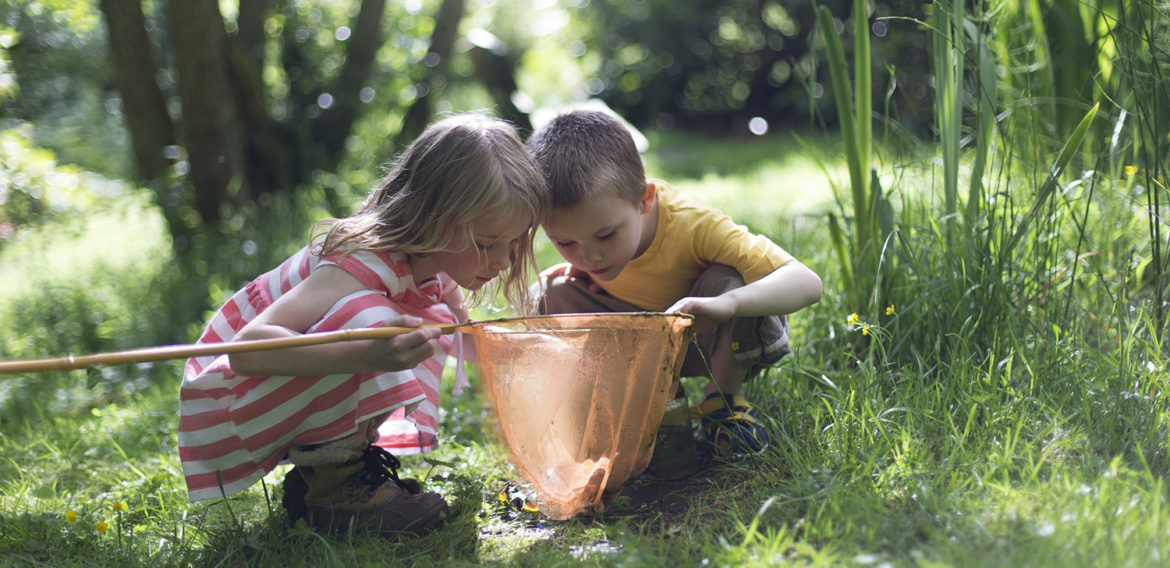How to Raise Nature-Loving Kids in a Media-Loving World
by Kate Koch-Sundquist
“It smells good out!” Junior declared, standing in the open doorway after dinner. It had been an unseasonably mild week, the first hints of spring revealing themselves in a warm southerly breeze and jackets left hanging inside.
A day of rain had washed everything, and now, tonight, the sky was clearing again and bulbs were just beginning to push through the rich soil. The air felt extra oxygenated, smelling of dirt and grass and fresh clean nothingness. Junior stood in the open doorway after dinner, taking in big gulps of it as though he were still hungry. Little Bear, perched next to him, noticed the sound first and cocked his head slightly.
“What’s that mama?” he asked. “What’s that noise? Birdies?” I stood with them and heard the first peepers of the season.
“Those are frogs, sweetie. Little, tiny frogs who live in the swamp back there.” Junior’s eyes went big and his mouth dropped open. Little Bear mimicked him. I wish I had a picture of them in that moment. Their pure delight and awe of the natural world written all over their faces.
I once wrote about six ways that I convince my kids to go outside on a daily basis. But since I wrote that, I’ve reflected a lot on why these methods are successful and I have to admit that there’s a lot more to it than getting them out the door each day. My kids go outside daily because they want to go outside daily. In fact, they love being outside. It is easily their happy place.
So how did I get so lucky? Is it genetic? The fact is, I have worked with purpose to instill these values in my kids, and it is not a coincidence that they have grown into who they are today. But it’s also not that hard.
Here are six ways that you can raise kids who love nature too.
1. Create family traditions that include nature.
We have a few family traditions that involve time spent outdoors, but my favorite is our full moon walks. Each month, regardless of the weather, we gear up after dinner and venture outside to enjoy the full moon. Even on stormy nights when it’s not visible, we go out. The kids think that being outside after dark is a great adventure, and they are slowly picking up on the moon’s phases. I don’t force them to participate, but so far I have always had the company of at least one of them on my walks and usually both choose to come along. Create a new family tradition that involves being outside. It could be collecting shells, stones or acorns at a favorite place. It could be Sunday morning walks. It could be lighting candles along the walkway or reading a bedtime story outside. To increase your chance of successful follow through, choose something that’s easy to accomplish but still feels special. For more ideas, check out our list of 20 Family Traditions That Will Teach Your Kids To Love Nature!
2. Encourage a sense of wonder and curiosity.
It is easy to forget how magical our world is. On my own, I would have easily missed that first chorus of frogs chiming in from beyond our back fence this week. Try to be mindful of the smallest signs of natural beauty and point them out to your kids often and with reverence. In summer, draw their attention to worms and butterflies, flowers that bloom anew all season long and those that die after just a week, stars and fireflies, puffy cumulus clouds and thunderstorms on the horizon. In fall, watch how the color changes on a single leaf over time, note the later sunrise and brisk mornings, the first frost if you have one and the unusual warm days sometimes still lingering. Winter may bring snow or sleet or hail or rain, the shortest day of the year and patterns of ice crystals on the windows. Spring brings tiny buds and bulbs, grass that turns green again, days growing longer and fresh mud for months. Point out small changes that you take for granted. Encourage questions and if you don’t know the answer, look it up together. Kids who notice nature are more likely to appreciate its subtleties.
3. Share your previous adventures with your kids and use them to inspire new ones together.
We love to pore over old photos with the kids, pointing out favorite hikes or sailing grounds that we explored before they came onto the scene. The kids love to hear about the amazing adventures that we’ve experienced, and they long to come along on some of their own. Sharing ours inspires their own imagination and passion. We set new goals together and talk about how we’ll work to make them happen. When the kids understand that backcountry camping requires long hikes with packed gear, they are more likely to come along on shorter hikes that build endurance towards their goal.
4. Provide unstructured playtime outdoors, away from playgrounds.
Give your kids time to explore nature on their own in an unstructured way. Playgrounds may be a great place to meet friends or burn off some excess energy before bedtime, but to really appreciate nature kids need to have time to immerse themselves in it, and most playgrounds are not natural environments. Away from manmade play, kids use their own imaginations and are more likely to pay attention to their environment. Logs become balance beams, trees become climbing structures and bushes become hiding spots. As difficult as it seems at first, bite your tongue and allow your children to explore and discover their world independently. You’ll be amazed at how much they learn through their own experiences.
5. Surround yourself with like-minded friends.
Use peer pressure to your advantage. Reach out to other families who share your values and coordinate some adventures together. If you aren’t sure who to invite on your weekend hike, ask your kids. When their friends buy in, they are more likely to buy in too. Some of our best friends and favorite memories were made on rainy days in the woods.
6. Create a nature-rich environment in your home.
You don’t always have to go outside to create lasting connections with nature. Bringing plants into your home, filling your bookcases with field guides and reading nature rich stories together are great ways to encourage curiosity and spark passion for the natural world. We collect stones, shells, pine cones and acorns to decorate our home. We engage the kids to research with us in books or online to answer their many questions about the environment, everything ranging from cloud types and plant identification to bird calls and weather forecasts.
Our kids are surrounded on a daily basis by media that pushes technology, processed foods, medication and the importance of being faster and better at everything we do. By providing them with the opportunity to slow down and appreciate the natural world around them, we ground our children in the bigger picture and allow them to experience childhood more simply. They will have a lifetime to experience the priorities of adulthood. What’s the rush to start now?










No Comments